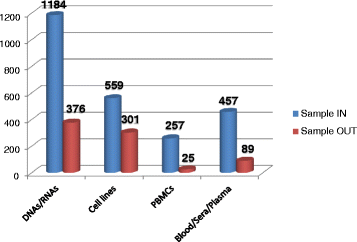The alliance between genetic biobanks and patient organisations: the experience of the telethon network of genetic biobanks
- PMID: 27776540
- PMCID: PMC5078978
- DOI: 10.1186/s13023-016-0527-7
The alliance between genetic biobanks and patient organisations: the experience of the telethon network of genetic biobanks
Abstract
Background: Rare diseases (RDs) are often neglected because they affect a small percentage of the population (6-8 %), which makes research and development of new therapies challenging processes. Easy access to high-quality samples and associated clinical data is therefore a key prerequisite for biomedical research. In this context, Genetic Biobanks are critical to developing basic, translational and clinical research on RDs. The Telethon Network of Genetic Biobanks (TNGB) is aware of the importance of biobanking as a service for patients and has started a dialogue with RD-Patient Organisations via promotion of dedicated meetings and round-tables, as well as by including their representatives on the TNGB Advisory Board. This has enabled the active involvement of POs in drafting biobank policies and procedures, including those concerning ethical issues. Here, we report on our experience with RD-Patient Organisations who have requested the services of existing biobanks belonging to TNGB and describe how these relationships were established, formalised and maintained.
Results: The process of patient engagement has proven to be successful both for lay members, who increased their understanding of the complex processes of biobanking, and for professionals, who gained awareness of the needs and expectations of the people involved. This collaboration has resulted in a real interest on the part of Patient Organisations in the biobanking service, which has led to 13 written agreements designed to formalise this process. These agreements enabled the centralisation of rare genetic disease biospecimens and their related data, thus making them available to the scientific community.
Conclusions: The TNGB experience has proven to be an example of good practice with regard to patient engagement in biobanking and may serve as a model of collaboration between disease-oriented Biobanks and Patient Organisations. Such collaboration serves to enhance awareness and trust and to encourage the scientific community to address research on RDs.
Keywords: Agreements; Biobanking; Networking; Patient involvement; Patient organisations; Rare diseases; Research; Sample and data centralisation.
Figures


References
-
- Filocamo M, Baldo C, Goldwurm S, Renieri A, Angelini C, Moggio M, Mora M, Merla G, Politano L, Garavaglia B, Casareto L, Bricarelli FD. Telethon network of genetic biobanks staff. Telethon network of genetic biobanks: a key service for diagnosis and research on rare diseases. Orphanet J Rare Dis. 2013 - PMC - PubMed
-
- Thompson R, Johnston L, Taruscio D, Monaco L, Béroud C, Gut IG, Hansson MG, 't Hoen PB, Patrinos GP, Dawkins H, Ensini M, Zatloukal K, Koubi D, Heslop E, Paschall JE, Posada M, Robinson PN, Bushby K, Lochmüller H. RD-Connect: an integrated platform connecting databases, registries, biobanks and clinical bioinformatics for rare disease research. J Gen Intern Med. 2014 - PMC - PubMed
-
- Graham CE, Molster C, Baynam GS, Bushby K, Hansson M, Mascalzoni D, Kole A, Mora M, Monaco L, Bellgard M, Carpentieri D, Posada M, Riess O, Rubinstein YR, Schaefer F, Taruscio D, Terry SF, Zatloukal K, Knoppers B, Lochmüller H, Dawkins HJS. Current trends in biobanking for rare diseases: a review. J Biorepository Sci Appl Med. 2014;2:49–61. doi: 10.2147/BSAM.S46707. - DOI
MeSH terms
Grants and funding
LinkOut - more resources
Full Text Sources
Other Literature Sources
Medical
Miscellaneous

